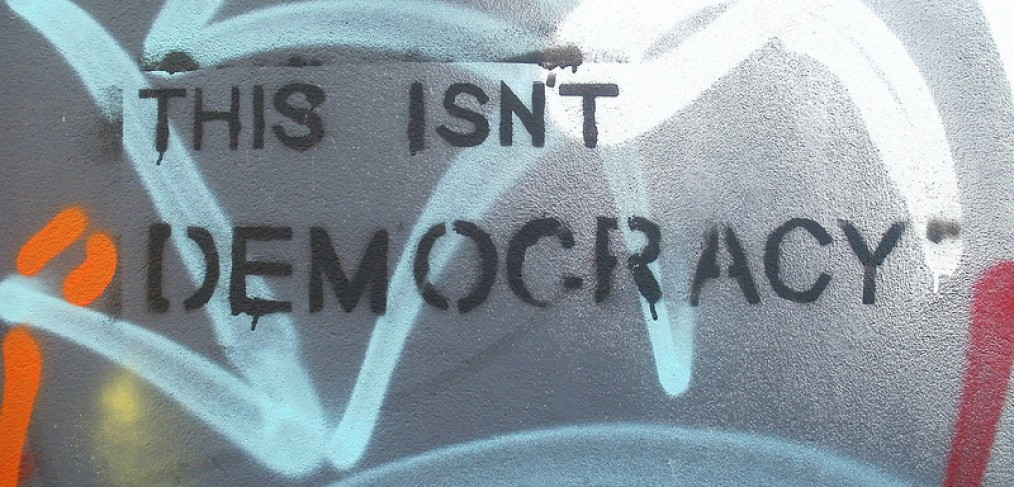
Why Is Market Fundamentalism So Tenacious?
David Bollier
One of the great economists of the twentieth century had the misfortune of publishing his magnum opus, The Great Transformation, in 1944, months before the inauguration of a new era of postwar economic growth and consumer culture. Few people in the 1940s or 1950s wanted to hear piercing criticisms of “free markets,” let alone consider the devastating impacts that markets tend to have on social solidarity and the foundational institutions of civil society. And so for decades Polanyi remained something of a curiosity, not least because he was an unconventional academic with a keen interest in the historical and anthropological dimensions of economics.
 As the neoliberal revolution instigated by Reagan and Thatcher in the 1980 has spread, however, Polanyi has been rediscovered. His great book – now republished with a foreword by Joseph Stiglitz – has attracted a new generation of readers.
As the neoliberal revolution instigated by Reagan and Thatcher in the 1980 has spread, however, Polanyi has been rediscovered. His great book – now republished with a foreword by Joseph Stiglitz – has attracted a new generation of readers.
But how to make sense of Polanyi’s work with all that has happened in the past 70 years? Why does he still speak so eloquently to our contemporary problems? For answers, we can be grateful that we have The Power of Market Fundamentalism: Karl Polanyi’s Critique, written by Fred Block and Margaret R. Somers, and published last year. The book is a first-rate reinterpretation of Polanyi’s work, giving it a rich context and commentary. Polanyi focused on the deep fallacies of economistic thinking and its failures to understand society and people as they really are. What could be more timely?
The cult of free market fundamentalism has become so normative in our times, and economics as a discipline so hidebound and insular, that reading Polanyi today is akin to walking into a stiff gust of fresh air. We can suddenly see clear, sweeping vistas of social reality. Instead of the mandarin, quantitative and faux-scientific presumptions of standard economics – an orthodoxy of complex illusions about “autonomous” markets – Polanyi explains how markets are in fact embedded in a complex web of social, cultural and historical realities.
Markets can only work, for example, if political and legal institutions contrive to transform people, land and money into assets that can be bought and sold. Polanyi calls these “fictional commodities” because people, land and money are not in fact commodities. People and land have their own existence and purposes apart from the market – and money is a social institution, even if many pretend that gold is a self-evident medium of value.
Notwithstanding these realities, capitalist societies ahve created these fictional commodities. People have in effect been transformed into units of “labor” that can be bought and sold in the market, and discarded when their value is depleted. Land, too, is treated as a market asset that has no connection to a larger, living ecosystem or human community. Inevitably, people and users of land (and ecosystems themselves) rebel against their treatment as raw commodities. The result is a permanent counter-movement against those who insist upon treating people and land as commodities.
Unlike Keynes, who was willing to accept some of these economic illusions in order to have political impact, Polanyi rejected them as a recipe for a dangerous and unachievable utopianism. That is in fact what has emerged over the past several generations as business ideologues have advanced quasi-religious visions of free market fundamentalism. The planet’s natural systems and our communities simply cannot fulfill these utopian dreams of endless economic growth, vast consumption of resources and the massive social engineering. And yet it continues.
Polanyi was courageous enough to strip away the pretenses that the economy is a “force of nature” that cannot be stopped. The economy, he said, is an “instituted process,” not a natural one, and it can only survive through massive governmental interventions and cultural regimentation. The free market system is hardly autonomous and self-executing. It requires enormous amounts of government purchasing, research subsidies, legal privileges, regulatory agencies to enhance fairness and public trust, military interventions to secure access to resources and markets, and the sabotage of democratic processes that might threaten investments and market growth. The 2008 financial crisis revealed in outrageous detail how financial markets are anything but autonomous.
So what accounts for the insidious power of market fundamentalism and its illusions? Why do its premises remain intact and influential in the face of so much contrary evidence?
Block and Somers point to a closed and coherent ideational scheme that knits together several key belief systems. The first is the idea that the laws of nature govern human society, and thus the workings of the economy are seen as a biological and evolutionary inevitability. A second theme is the idea of “theoretical realism,” a belief that the theoretical schema is more true and enduring than any single piece of empirical evidence, and thus one can argue from the claims of theory and not from facts. Free market narratives assert their own self-validating claims to what is true; epistemological categories trump all empirical challenges.
Finally, a “conversion narrative” enables free marketeers tell to neutralize and delegitimate any contrary arguments, and enabling them to introduce its alternative story. This approach is routinely used to re-cast the reasons (and blame) for poverty. Instead of acknowledging institutional or structural explanations for why many people are poor, the free market narrative boldly attacks government for making people poor through aid programs. Government programs supposedly have a perverse effect, aggravating, not aleviating poverty. The poor are cast as morally responsible – along with government – for their own sorry circumstances. Thus, a higher minimum wage is perverse, say free market champions, because it will hurt the poor rather than help them.
What makes The Power of Market Fundamentalism so illuminating is its patient, careful reconstruction of these recurring and deceptive polemical patterns. The wealthy invoke the same rhetorical strategies again and again over the course of hundreds of years in extremely different contexts. With their mastery of an enormous contemporary literature, Block and Somers document the remarkable parallels and show just how deep and durable Polanyi’s analysis truly is.


